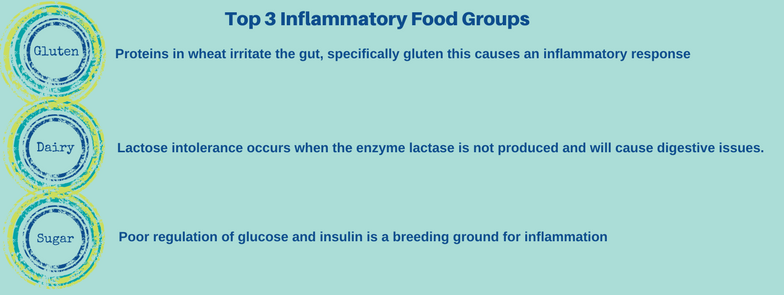Is the Anti-Inflammatory Protocol a piece to the puzzle?
Holistic Nutritionists have a unique set of analytical skills when it comes to making recommendations. Like solving a puzzle, we formulate how the pieces fit together and find what is missing. We have a way of working backward, from the symptoms back to the root cause. Looking at current and past symptoms we can make recommendations, not always relying on tests and screenings. Seeing and respecting biological individuality is part of our approach. The Anti-Inflammatory protocol is one of the many helpful tools we can use to find those missing pieces.
While working on a puzzle, you see a picture of the way it should look. As you match the pieces to the open shapes, you find some don’t fit. Some pieces might be missing. You could approach solving a puzzle with trial and error, one piece at a time, or look at the big picture. Like a physical puzzle, more than one approach that can be used. This same approach can be applied when addressing symptoms in a person’s body. This one tool alone may not solve the whole puzzle but it will give us clues and point us in the right direction
True, but Partial
One of my favorite concepts, when addressing current symptoms and exposing root causes is one put forth by Functional Nutritionist, Andrea Nakayama of Replenish PDX. Andrea adopted the concept “True, but Partial” from Ken Wilbur the Author, and applied it to the Holistic approach. When it comes to tests and screenings, you get true results, yet they are still partial. Space between is still left to uncover. What happened between the previous state of health and the present condition?
Test results alone leave out the individuality and the experiences that could have contributed to a disorder. For example, things like emotional trauma or exposure to certain environments will not show up on a food sensitivity test. There will always be a place for tests and screenings but keep in mind, things can be missed on an individual level.

Why should you use the Anti-inflammatory protocol?
Normally, inflammation is good as it helps the body heal from injury, it has an important purpose. It’s when the inflammation is deep inside the blood vessel chronic disease can be triggered.
Eliminating the top 3 inflammatory food groups is a good starting point. Even if issues don’t resolve afterward, this gives us room to dig deeper. What is still in the diet or environment that could cause issues? It could be anything from Caffeine to nightshades to mold. After following a protocol like this, you will always have new information that you didn’t have before. Did things get better? Worse? Did they stay the same?
Often, if things got worse or didn’t change at all clients and practitioners alike can get discouraged. This is not necessarily a bad thing. A lack of results tells us something too!
While this diet could be adopted long term, it is meant to help you find where the problem originated. Functional Nutritionist, Andrea Nakayama of Replenish PDX likes to call it, “Clearing the Muddy Waters”. Eliminating the top inflammatory foods can uncover the source of our issues.
It’s important to remember though that even some “healthy” foods cause problems in a compromised system.
Why did I try the Anti-Inflammatory protocol?
For nearly 10 years I experienced debilitating pain in my lower left side and horrible PMS. Doctors were no help as they gave me a myriad of problems the pain could be. One doctor told me it was insufficient fiber and “The only organ in that area is the large intestine”. Others told me it was endometriosis, which required diagnostic surgery. The most frustrating suggestion was “bad cramps”. I knew something wasn’t normal about how I felt. I found a doctor willing to order an ultrasound which revealed large ovarian cysts. Guess where they were? On my left side! Fortunately, the Doctor respected my desire to see if it would resolve on its own without surgery.
I had to try something and see if I could fix this with my diet. I began an anti-inflammatory protocol and eliminated caffeine as well. After the 25 days were over, I continued avoiding refined sugars, some natural sweeteners and all sources of caffeine. Even chocolate! 3 months later, at my next ultrasound, my cysts were gone and there was no evidence that they were ever there.
I figured out I am sensitive to caffeine and my liver has a hard time processing it. This alone can be a starting point for other issues. Liver dysfunction is related to some female issues, but I had never made the connection in my own body. Also, digestive issues that I had learned to live with resolved when these food groups were eliminated. I had an opportunity to use more diverse ingredients that I may not have tried otherwise.
While I don’t see it as a “be all end all” solution, it provides a new pathway of information about what is going on inside the body.
Challenges you/your client may need to prepare for
- Making things ahead of time can keep you from being tempted! In a client setting, provide clients with plenty of snack ideas.
- Eating at restaurants and family events can be a challenge at times. If possible, look at the menu ahead of time. Restaurants are usually accommodating when making special requests. Make something ahead of time that you can take with you in case of a family event.
- When recommending this protocol warn clients of possible withdrawal symptoms and temporary change in bowel movements.
- Plan your meals and shopping trips ahead of time to make the process stress free.
- You can learn about a client by the way they follow or don’t follow recommendations. Eliminating these food groups simultaneously may be difficult, so give your client plenty of options. Remind them that this is not all or nothing. Perhaps, let them pick one food group at a time to eliminate.
Anti-Inflammatory Protocol Basics
Duration:
- 14-25 days eliminate top 3 inflammatory food groups
- Slowly introduce foods back and track symptoms or lack thereof
Top inflammatory food groups:
- Refined/processed Sugars, Wheat, Dairy
Mealtime Tips:
- Chew your food! Digestion begins in the mouth. Chewing your food completely aids digestive organs, allows them to use less energy and helps stimulate enzymes to process different nutrients
- Try to avoid drinking during meal time especially cold drinks, this can impair digestion. Drink before meals or take sips during mealtime if necessary
- Take the time to bless your food or state an affirmation before meal time. This gives you time to smell the food, appreciate it and it stimulates salivary glands so your body is ready to digest.
Ideas of items to incorporate into your Anti-Inflammatory protocol:
- Organic seasonal fruits – Apples, Pineapple, Berries (berries in particular – high in antioxidants. Low in sugars)
- Organic seasonal vegetables – Broccoli, Spinach, Asparagus
Wild caught fish – Omega 3 sardines, salmon (vegan option – flax oil, hemp oil etc.) - Oils – Avocado oil, Cold pressed olive oil (not to be used in high heat cooking), Coconut oil
- Spices -Ginger, Garlic, Cinnamon, Oregano, Turmeric
- Drinks -Green, Oolong teas
- Seeds – Freshly ground flaxseed in moderation
Anti-Inflammatory Meal Planning Tips:
- Aim for variety
- Aim for fat, fiber, and protein at every meal
- Eat fresh food as much as possible
- Read the labels if using any packaged food to ensure no inflammatory ingredients are present
Beneficial tools during the Anti-Inflammatory protocol:
- Food Journal – Keep track of what you eat and how it affects you, the way you feel and your bathroom habits.
- Self-care – Make sure to take time for yourself and nurture yourself. Do something each day that provides you with movement and that relaxes you.
Sample one-day Meal Plan
Breakfast:
Coconut & Sweet Potato Muffins
1 small organic sweet potato, roasted (1 cup, packed)
3 organic, free-range eggs, lightly beaten
¾ cup of organic canned coconut milk
2 tbsp of organic olive oil
½ cup of pure organic maple syrup
1 cup of organic brown rice flour
¼ cup of organic coconut flour
1 tbsp baking powder
½ tsp pink Himalayan salt
1 tbsp of ground cinnamon
1 tsp of ground ginger
⅛ tsp of ground cloves
⅛ tsp of ground nutmeg
Bake at 350° for 30 minutes
Lunch:
Cauliflower Rice with Turmeric
1 head cauliflower blended with food processor
2 garlic cloves
¼ cup golden raisins
1 onion, large
2 tsp turmeric
1 tsp black pepper
½ cup almonds
1 bunch parsley
Cook over medium heat 7 minutes in a skillet
Snacks :
Homemade Guacamole and Celery sticks
½ avocado mashed
3 mini peppers, chopped small
¼ onion, chopped small
2 tbsp lime juice
1 tsp minced garlic
1 tsp cayenne pepper
3 large celery stalks cut in strips
Mix to desired consistency can use a food processor if you wish
Dinner:
Blueberry Salmon Salad
170 g smoked salmon
2 tbsp red onion
½ avocado, small ripe
2 cups baby spinach
1 tbsp mint and basil, fresh
2 cups watercress
½ cup blueberries, fresh
2 tsp honey, raw
¼ cup orange juice, freshly squeezed
1 sprinkle sea salt + black pepper
2 tbsp apple cider vinegar
½ cup olive oil, extra-virgin
2 tsp dijon mustard
¼ cup walnut halves/pieces, raw unsalted
Toss all ingredients
Greetings! I am Sarah, a Holistic Nutritionist out of the Carolinas in the US. My mission is to empower individuals with the information and resources they need to take care of themselves and their families. With the infinite amount of information available nowadays, you may be able to find answers but usually there is a lot of conflicting information and you have to sift through hundreds of articles which, can be overwhelming. I want to help simplify things and make holistic nutrition basics easier to access for those who are seeking.




